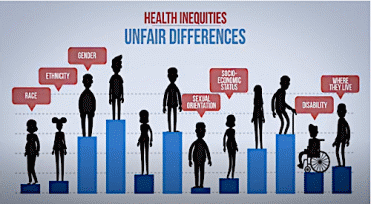
I chose the above picture, found on the Internet, as it depicts the realities of the inequities in healthcare, amongst other areas of life. In the picture, various vulnerable groups are represented, such as those with disabilities. Furthermore, it draws attention to the unfair differences in treatment by professionals that one’s race, ethnicity, gender, socio-economic status, sexual orientation, and place of living might cause. In order to convey this message, the image shows the different people at different heights, using the pedestals as a metaphor for different advantage points. In this example, the vulnerability causes inequity in treatment and healthcare.
Health inequities must not be confused with inequalities, since the former are concerned not simply with offering the same opportunities and treatment to everyone but taking into consideration the background of the individuals. According to Sossauer et al. (2019), vulnerability is defined as “the likelihood of having one’s interests unjustly considered,” which leads to inequity. This phenomenon is dangerous as it can lead to a decrease in the level of healthcare services. There are various causes for the inequities but vulnerability, as illustrated by the picture, is a major reason.
The picture is very accessible and has a great reach to the masses. Since it is a simple cartoon, it is easy to understand, and invites further conversation and research of the topic. Therefore, it is incredibly useful in raising awareness for the issue of inequity in healthcare. While it is not a problem that can be easily fixed, raising awareness and introducing the issue to people. One of the most important parts of solving the problem is identifying it and making sure that it is prevented at the core. In the case of vulnerability and inequity, this means knowing which groups are at risk of being mistreated, so that they can be protected.
References
Sossauer, L., Schindler, M. & Hurst, S. (2019). Vulnerability identified in clinical practice: a qualitative analysis.BMC Medical Ethics, 20(87). Web.
[Untitled illustration of Health Inequities]. U.S. Department of Veteran Affairs. Web.